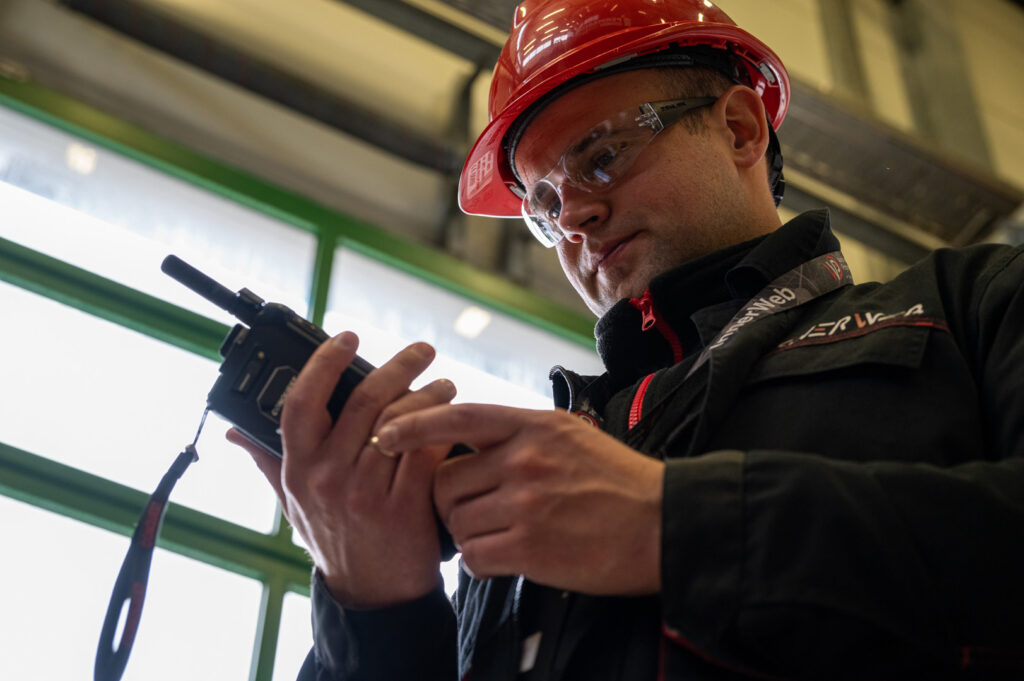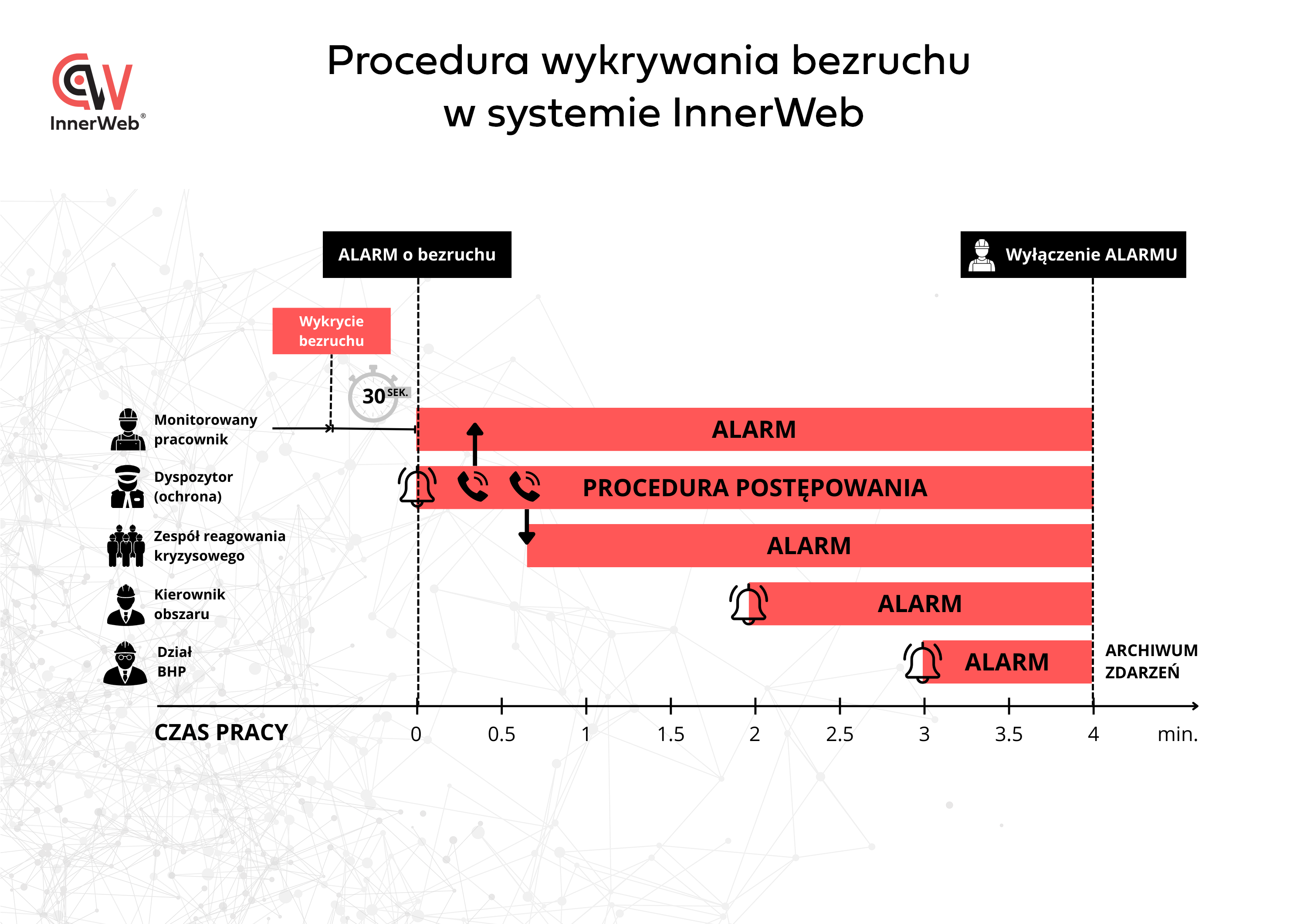IMMOBILITY OF LONE WORKERS
Security is one of the most crucial elements of any workplace. What if a worker falls, loses consciousness, or faints… how quickly will anyone find out and react appropriately? How can we ensure a high level of safety for workers who are alone at their workstations?
Such positions carry additional risk because in the event of fainting, falling, etc., there are no witnesses or people who could quickly provide assistance on-site. The solution to this problem is a motion detection feature based on geolocation.
Safe workplace
The purpose of immobility detection is to ensure the highest level of safety for employees. We want to ensure that employees feel safe at work and return home safe and sound every day. In life-threatening situations, seconds or minutes are often crucial. If anyone present nearby reacts quickly to the accident, the chances of survival of the injured person increase. If there is no immediate threat to life, a quick response can lead to fewer complications or less permanent damage to health.
Independent workstations, where other employees are not in close proximity, are exposed to delayed reactions in the event of fainting or accidents. Bearing this in mind, the InnerWeb team has begun work on creating a system that will improve the safety of individuals working without the presence of other employees.
How does it work?
The implementation of the service involves installing a network of iBeacon radiobeacons on the premises of the plant. Employees must be equipped with smartphones with the InnerWeb application installed. The system continuously provides us with information about the whereabouts of people on the premises of the plant. The administrator has the ability to activate the Immobility Detection function for selected employees.
This module involves triggering alarms and notifications when no movement is detected for a specific employee. The time after which the alarm should be activated is configurable. The function aims to ensure a high level of safety, especially for those who work independently, in positions without third parties.
For example, we can set the alarm to activate for specific employees automatically after 20 seconds of detecting no movement. If the employee remains inactive during this time, they will receive a notification about the detection of immobility. They can either confirm their rest or cancel the alarm.
Confirmation of immobility activates the static mode, which operates for 15 minutes and prevents the sending of the above notifications. This may indicate a break from work or working at a computer. After 15 minutes, the alarm system will resume operation, triggering notifications after 20 seconds of no movement.
If the employee does not respond to the alarm, the supervisor will receive a notification of this situation. They should then follow the procedure. What does this involve? The alarm system is managed by a security guard, who must contact the employee by phone in the event of an alarm. If the employee is not available, the security guard should send designated individuals to the specified location to verify the threat.
This enables the team to react quickly in life-threatening or health-threatening situations, where seconds are often crucial.

The InnerWeb system and real-time monitoring of employee movement.
The entire system is based on the geolocation of resources, enabling real-time monitoring of employees. Thanks to this, the mentioned security guard knows exactly where to go.
The proprietary iBeacon radiobeacons network installed on the premises allows for monitoring employees in various areas. Additionally, access to the location of tools and peripheral devices is available.
It is important to emphasize that employee monitoring ensures efficient evacuation. What does this mean? In the event of a threat situation, with current information about the location of individuals on the premises, we know exactly where the injured parties are. We know who remained in the building and where to look for them.
The Labor Code and monitoring of employees
According to the provisions of the Labor Code, an employee performing duties alone in places where there are health or life hazards must report to their supervisor. The employer determines the method and timing of these reports. Fulfilling this obligation through phone calls or text messages can be cumbersome. Not only does the lone worker struggle with this responsibility, but also the supervisor, who receives many such calls and messages daily. The more solitary individuals in positions without third parties, the more notifications, calls, and the need for follow-ups. It is also easy to forget to always transmit the message on time, especially amidst other tasks.
One system provides the highest level of security in different areas of the company
InnerWeb’s mission is to provide continuous development in organizing work, improving productivity and enhancing security. The application facilitates both work and communication. The no-movement detection module described eliminates the need for constant reporting during a shift. The system provides monitoring of employees so that we have information about where they are at any given time and whether they are on the move or in static work mode. Without the need to make phone calls and send messages, we have a range of information about the progress of work. A possible life- or health-threatening situation can be detected immediately. At the same time, the response to such incidents is fast.
Benefits of implementing lone worker immobility detection service
In an era of galloping development of information systems and ubiquitous digitization, we are meeting needs. Guaranteeing a secure workplace is a priority for us. We realize it through innovative methods that bring a number of benefits:
- Increasing the safety level of lone workers
- Increase the level of safety for workers performing work in inaccessible areas
- Ability to respond immediately in the event of a threat to a worker's health or life
- The possibility of replacing a two-person team with a system in which the required tasks can be performed by one person.
Case study
Want to know the real benefits of using modern technology to monitor employee safety? Read a case study of the implementation of a lone worker immobility detection procedure.



